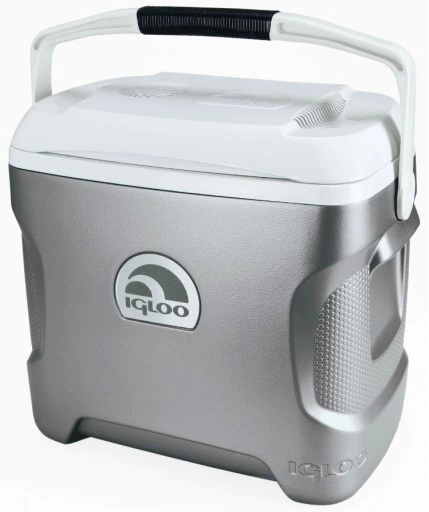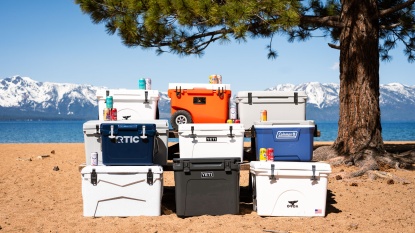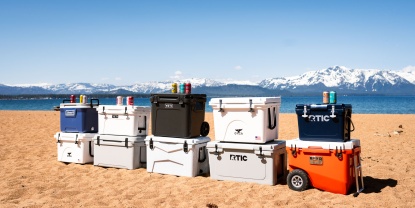Igloo Iceless 28 Review
Our Verdict
Our Analysis and Test Results
Igloo makes coolers. And nothing else. They make designs across the whole available spectrum, as well as creating entire categories. The thermoelectrically cooled Iceless 28 model is just such a category. This unique offering may be just the ticket for certain consumers.
Insulation Value
For every rule there is an exception. In our review of the best coolers, we detail the nature of these products. Basically, all work to simply slow the temperature change of the contents. Insulated walls attempt to mitigate the effects of the second law of thermodynamics. However, from the perspective of your food and drink, the Igloo Iceless 28 transcends physics. Just like your home refrigerator, this box can cool the air and contents. Unlike your refrigerator, you can take this Igloo wherever you go. The electric mechanism in the lid cools the contents to approximately 35 degrees Fahrenheit below the ambient conditions. This is what Igloo claims, and our testing confirms.
In our head-to-head testing the Iceless 28 scored right in the middle. Whether you are cooling the contents with ice or electricity, effective insulation is crucial. In order to perform an effective comparative test, we needed to use the same seven-pound bag of ice in the Iceless 28 as we used in the other coolers. Please note that Igloo explicitly states that no water can get into the vent/cooling mechanism in the lid. Melted ice in a jostling cooler presents a hazard of frying the electrical mechanisms. There are certainly situations in which it may make sense to use ice in this so called Iceless version. You may be driving long distances to a camp site. You can power and cool the cooler with auto electricity while driving, but may not be able to keep it plugged in through your camping weekend. In this case, use ice carefully.
Ease of Use
This cooler is small and handy. In an unexpected advantage of the thermoelectric cooling mechanism, much more of the internal space can be used for food and drink. In a traditional insulator, space must be left for ice. Eliminate the ice, as the Iceless 28 can, and all of the space is available for consumables. We estimate that leaving the ice out of this model makes it as functional as a version half again as big. If you read our How to Choose a Cooler article and decide you need a 40 quart model with regular ice usage, you'll find you can get away with this 28 quart offering. Provided, of course, that you can keep things cool with electricity. Also notable with this cooler is the liberating lack of melt water. In regular coolers, melted ice penetrates food packaging and obscures the contents at the bottom. In the Igloo Iceless 28 no such problems exist. It is worth noting, however, that even in the fairly dry climates we tested in, the cooling mechanism results in some condensation on the contents. Simply, and again referencing high school physics, the cooler takes warm outside air and lowers its temperature. Inevitably this cooled air can hold less water vapor. Condensation results. Pack accordingly. Our testers found a little annoyance in the interaction of the handle and power cord. When plugged into power, the handle cannot swing freely back and forth. This is easily managed, but needs attention of the user.
Finally, in the ease of use category, note that this model absolutely cannot be used as a seat. The overall structure is plenty strong, but the lid is not suited for sitting. The cooling mechanism is inside the lid. Perforated vents bound the cooling mechanism above and below. The plastic of the vent flexes even under light load and hits the fan. When the cooler is running, the user gets immediate feedback upon the application of excessive load.
Durability
We had no issues with the durability of the Iceless 28 in our testing. The overall construction as well as the hardware held up just fine. As compared to the Editors' Choice Yeti Tundra 45, this model feels flimsy and light. And our experience with long-term testing of similar models suggests that hinges and handles may loosen and break down with time. Additionally, note that this is the only mechanized or powered cooler in our testing. While our testers had no issues with the reliability of the thermoelectric cooling mechanism, this is a potential failure point.
Portability
Even when completely full of dense food and drink, an ice box this size is easily transported by an adult. The large folding handle and offset, contoured shape makes for easy one-handed “suitcase” style carry. Develop a system for managing the cords, and you'll have no issues moving this cooler around.
Value
For its size, this is not a cheap cooler. However, as noted above, this model holds more than its size would indicate, given the space available that would normally be filled with ice. The best value-added function of this cooler is the fact that you'll spend far less on ice. If you travel by car a great deal, and can keep this baby plugged in, you'll virtually never need to buy ice again. At $2-3 a bag, with most coolers requiring a bag of ice every 2-3 days, this model can pay for itself in a few months of travel.
Conclusion
We are proud to offer our Top Pick award to this unique cooler. It stands out for its technology and efficiency. Provided the user can keep it near a power source, this design will streamline remote food and drink cooling.












